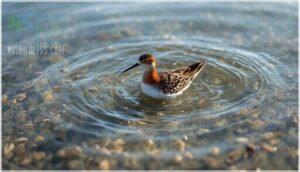This site is supported by our readers. We may earn a commission, at no cost to you, if you purchase through links.

You’ll often find them hanging out in groups, creating a spectacle as they feast on berries with gusto.
They’re little daredevils, sometimes getting tipsy from fermented fruit!
Cedar waxwings are not picky, thriving in forests or making themselves right at home in your neighborhood. They’re expert berry connoisseurs and insect snatchers.
Intrigued? There’s so much more to these social birds! Get ready to discover their fascinating world.
Table Of Contents
- Key Takeaways
- Physical Characteristics
- Habitat and Distribution
- Diet and Foraging
- Social Structure and Behavior
- Reproduction and Nesting
- Conservation Status and Threats
- Migration Patterns and Timing
- Calls and Vocalizations
- Attracting Cedar Waxwings to Your Yard
- Interesting Facts and Trivia
- Frequently Asked Questions (FAQs)
- Is it rare to see a Cedar Waxwing?
- Where do Cedar Waxwings live?
- Where can I find Cedar Waxwing?
- Do Cedar Waxwings eat at bird feeders?
- How do Cedar Waxwings choose mates?
- What colors are juvenile Cedar Waxwings?
- What are the common predators of Cedar Waxwings?
- Do Cedar Waxwings eat seeds?
- How do Cedar Waxwings react to human presence?
- Conclusion
Key Takeaways
- You’ll find Cedar Waxwings hanging out like berry buffs at their favorite fruit buffet. These sleek birds aren’t shy, flitting through woodlands and backyards with a knack for finding ripe treats. Their diet is mostly berries, but they’ve also got a talent for aerial insect hunting.
- With their striking masks and dashing plumage, Cedar Waxwings are the fashionistas of the bird world. You won’t miss their signature look—sleek brown, gray, and lemon-yellow shades accented by waxy red tips on their wings and a tail dipped in sunshiny yellow.
- Cedar Waxwings are not just pretty faces; they’re social stars of the avian world, often found in flocks chattering away with high-pitched "bzeee" calls. Their teamwork is on display as they engage in playful food sharing and courtship rituals that involve passing berries like love notes, much like the beak-to-beak feeding behavior of cardinals. https://avianbliss.com/do-cardinals-kiss/.
- Got a garden? Turn it into a Cedar Waxwing resort by planting fruit-bearing trees like serviceberries or mulberries. These birds are great at ignoring glances from curious humans, so they’ll swing by for a bite and perhaps even a splash in your birdbath.
Physical Characteristics
Get ready to spot these striking birds, as Cedar Waxwings flaunt a sleek blend of brown, gray, and lemon-yellow with a distinctive black mask, a common feature in many species.
They’re medium-sized with a square-tipped tail, and you’ll have to squint to see those red wax droplets on their wings!
Plumage and Coloration
Cedar Waxwings boast a stunning plumage, mixing brown, gray, and lemon-yellow. Identifying their black mask and red wing markings is like spotting hidden treasure just like a Scarlet Tanager.
Body Shape and Size
The Cedar Waxwing’s sleek, medium-sized frame and large head give it a distinctive look. Its compact wingspan and short, square tail are hallmarks of this elegant bird.
Beak Shape and Size
When checking out beak shape and size, Cedar Waxwings show beak adaptations that boost feeding efficiency and fruit handling. They’re like nature’s little fruit tweezers!
Crest and Tail Features
Just like their short, wide bills, cedar waxwings’ crests offer flair. Crest shape variation aside, tail feather patterns come alive during their intense molting cycles!
Sex and Age Differences
Though Cedar Waxwings look almost identical, their juvenile markings differ, showing fainter masks and dusky streaks. Males and females both sport that unique waxy plumage!
Habitat and Distribution
Cedar Waxwings are a versatile bunch, thriving in a variety of habitats from lush forests to urban gardens.
Cedar Waxwings are versatile and thrive in a variety of habitats, from lush forests to urban gardens.
Whether you’re spotting them feasting on berries in the countryside or flitting through your backyard, these charismatic birds seem right at home wherever there’s an abundance of their favorite foods.
Breeding Grounds and Migration Patterns
Now, let’s explore Cedar Waxwings’ breeding grounds and migration patterns! These birds adapt like seasoned travelers, choosing nesting sites based on climate impact, habitat changes, and breeding success.
Wintering Grounds and Food Sources
In winter, Cedar Waxwings rely on cedar berry dependence for survival. To better understand them, consider:
- Climate change impact
- Fruit availability
- Winter flock sizes
- Human-provided food.
Urban and Suburban Habitats
Cedar Waxwings adapt beautifully to urban life, seeking berries in your backyard. Human impact isn’t all bad—they find nest sites on suburban branches. Spot them frequently!
Woodland and Forest Habitats
Tucked within the lush woodlands, Cedar Waxwings thrive, nesting in the forest’s edge where berries and insects abound. Their adaptability shines as they navigate habitat changes.
Grassland and Desert Habitats
How do Cedar Waxwings adapt to grasslands and deserts? They cleverly nest near water sources and thrive on available berries, despite drought impacts and scarce desert food sources.
Diet and Foraging
You’re in for a treat when exploring the diet and foraging habits of Cedar Waxwings, as watching them devour berries with glee is like witnessing nature’s own fruit enthusiasts.
These birds are berry buffs but also agile insect hunters, making them fascinating foragers with a taste for life’s sweeter and crunchier offerings.
Berry Consumption and Preferences
When berry abundance is high, waxwings feast happily, preferring ripe ones. But watch out—too many fermented berries can leave them fruit-looped and tipsy!
Insect Consumption and Hunting Techniques
Cedar Waxwings supplement their fruit-heavy diet with a diverse array of insects, plucking them from foliage or snatching them mid-air with impressive aerial maneuvers.
- They feast on beetles, caterpillars, ants, and more, providing essential protein during the summer breeding season.
- Waxwings skillfully hover to snatch insects, then return to their perch to swallow the tasty morsels.
- Their insect-hunting prowess helps them thrive in a variety of habitats, from woodlands to urban areas.
Fruit and Nectar Consumption
Imagine spotting these feathery friends with their fruit preference for berries. They enjoy high sugar content nectar when berry ripening season offers delightful, juicy treats.
| Favorite Fruits | Nectar Availability | Sugar Content |
|---|---|---|
| Berries | High | High |
| Apples | Variable | Medium |
| Juniper Berries | Low | Low |
| Mulberries | Medium | High |
Supplemental Food Sources and Human Interaction
Want to charm Cedar Waxwings to your garden? Try this:
- Bird feeders: Offer berries and nuts.
- Fruit tree planting: Encourage visits to deter birds from your garden.
- Avoid conflicts: Secure fermented fruits!
Foraging Strategies and Social Behavior
You’ve explored supplemental treats; now picture flocks of Cedar Waxwings engaging in playful berry buffet strategies and food sharing—teamwork for winter survival and cunning predator avoidance
.
Social Structure and Behavior
Cedar Waxwings are highly social birds, often forming large flocks and nesting in small colonies.
These sleek songbirds have a fascinating repertoire of calls and vocalizations, from their signature high-pitched trills to their soft, sighing whistles.
Mating and Breeding Habits
When Cedar Waxwings choose a mate, it’s all about flair. Their courtship displays include passing berries back and forth.
- Nest site selection is important.
- Brood parasitism is a challenge.
- Parental care is shared.
Nesting and Incubation Behavior
Cedar Waxwings are clever architects when selecting nest sites, usually choosing trees with sturdy branches. Incubation lasts around 12-13 days. Both parents keep nests cozy, despite occasional brood parasitism by cowbirds.
Parenting and Chick-Rearing
In the cozy nest, parental care shines as waxwing moms and dads tirelessly feed their brood.
Balancing their diet, they guarantee fledgling success, with a berry here, an insect there—nature’s buffet for growing nestlings!
Communication and Vocalizations
Their high-pitched "bzeee" calls often alert you to their presence before you spot these social birds.
Listen for their sighing whistles as they communicate with flockmates.
Waxwings’ vocalizations serve various purposes, from coordinating movements to warning of danger.
Reproduction and Nesting
When Cedar Waxwings construct their nests, they might as well be right out of a DIY marathon, using materials like grass, twigs, and even hair to craft cozy cups high in trees.
Cedar Waxwings are social birds, and they happily raise chicks together.
You’ll be amazed to know that while Cedar Waxwings happily raise chicks together, they’re not too keen on unwelcome guests like Cowbird eggs, which don’t usually fare well in a berry-rich nursery.
Nest Construction and Materials
Imagine you’re a Cedar Waxwing; building a cozy home means gathering over 2,500 materials. Nest location matters—high enough for safety, with soft lining for warmth.
Egg Laying and Incubation
You’ve chosen the perfect nest site; let’s talk eggs! Cedar Waxwings lay a clutch of 3-5 pale blue-gray eggs, with the female handling incubation duties.
Nestling Development and Fledging
Once the chicks hatch, you’ll witness their rapid growth as the devoted parents work tirelessly to meet their insatiable food demands.
Fledglings eventually leave the nest, setting out on their own adventures.
Brood Parasitism and Cowbird Interactions
Cedar Waxwing nests become battlegrounds in the Cowbird-Waxwing conflict. This parasitism impact challenges nestling survival while host defenses show fascinating evolutionary implications of nature’s clever tactics.
Nesting Success and Failure Rates
When picking a nest site, these birds consider predator threats and food availability. Climate impact and human influence can also affect nesting success with surprising results!
Conservation Status and Threats
You know, Cedar Waxwings might seem carefree while snacking on berries, but they face challenges like habitat loss and climate shifts that could turn their picture-perfect world upside down.
With stable populations for now, you can help make sure these feathered fashionistas continue to brighten our yards by supporting conservation efforts and keeping an eye out for the plump beauties in the berry bushes.
Population Trends and Stability
Rejoice, Cedar Waxwings! Their populations remain stable, thanks to their adaptability.
Savor their berry-filled feasts, but beware climate shifts that may disrupt their habitats.
- Stable populations, thanks to adaptability
- Climate change impacts food availability
- Human influence on habitat quality
Habitat Loss and Fragmentation
Imagine a bustling cityscape, where urban sprawl and forest clearing create fragmented landscapes. You can help habitat connectivity with conservation strategies, promoting harmonious coexistence between nature and urban life, like protecting nesting sites for the Marbled Murrelet.
Climate Change and Food Availability
Climate change can make berry scarcity a real pickle for Cedar Waxwings, causing range shifts and altered migration as fruit ripening changes and competition increases.
Human-Waxwing Conflicts and Hazards
Climate change leads us into human-waxwing challenges. These charming birds face:
- Window strikes while flying,
- Berry theft from your garden,
- Habitat loss due to development.
Conservation Efforts and Management Strategies
Though their numbers are stable, conserving Cedar Waxwings requires restoring berry-rich habitats and monitoring populations to mitigate climate change and human-wildlife conflicts. Get involved today!
Migration Patterns and Timing
You’ll find Cedar Waxwings setting out on remarkable migratory journeys, with spring and fall heralding their seasonal travels across North America.
These sleek birds aren’t just flying aimlessly; they strategically choose their wintering grounds and stopover sites based on weather changes and food availability, making them the ultimate berry connoisseurs on a grand road trip!
Spring and Fall Migration Routes
As Cedar Waxwings journey each spring and fall, their migration timing and route variations depend on weather impacts and climate change effects, offering unique stopover locations.
Wintering Grounds and Stopover Sites
As Cedar Waxwings head south, they seek wintering grounds rich in berries.
Stopover sites are where these beauties can be spotted, as food availability matches their fruity cravings:
- Abundant berry bushes
- Shelter in evergreens
- Riverbanks and pond edges
Migration Speed and Distance
Cedar Waxwings zip across the continent at impressive speeds, covering hundreds of miles during their epic migrations. Weather and food availability shape their journeys.
Altitudinal and Latitudinal Migration
Flying isn’t just about distance; it’s about height too! Watch as waxwings adjust altitudinal and latitudinal migration routes—mastering elevation changes between breeding grounds and wintering ranges.
Weather and Environmental Factors
Changing weather—it’s not just for complaining! It affects Waxwings’ migration.
They follow:
- Favorable winds
- Temperatures
- Food availability
These factors help them survive the winter and find suitable habitats.
Calls and Vocalizations
Cedar Waxwings are chatterboxes, with their distinctive, high-pitched "bzeee" making them a joy to hear when taking a neighborhood stroll.
Their vocal repertoire, from contact calls to parenting signals, is as varied as their preference for the ripest berries in town.
Description and Function of Calls
Their high-pitched trills and sighing whistles serve as the soundtrack to your backyard adventures, guiding you to these social songsters.
Contact and Alarm Calls
Cedar Waxwing calls are like nature’s intercom for flock communication and predator detection.
Tune into alarm calls signaling:
- Danger near
- Distress signals
- Predator alert
- Flock coordination
- Safety warnings
Courtship and Mating Calls
If contact calls are the warm-up act, then Courtship and Mating Calls are the romantic duets, featuring unique song variations to charm and select perfect nest sites.
Nesting and Parenting Calls
While courting, Waxwings become chatty. Now, during nesting, listen for quieter calls as parents communicate with chicks and coordinate nest site selection. Relatably endearing, right?
Geographic Variation in Vocalizations
Intrigued by their diverse dialects? Cedar Waxwings’ calls can vary by region, with subtle differences in pitch, rhythm, and inflection. Listen closely – their songs are a regional symphony!
Attracting Cedar Waxwings to Your Yard
Want to make your yard a bustling hub for Cedar Waxwings?
With some inviting fruit-bearing trees,
a splash of fresh water,
and a few thoughtful touches,
you’ll soon be hosting nature’s finest in your own backyard!
Planting Fruit-Bearing Trees and Shrubs
Entice Cedar Waxwings to your yard by planting fruit-bearing trees like dogwoods, serviceberries, and mulberries.
Explore local nurseries for high-quality plants.
| Tree Type | Berry Season | Sunlight Needs |
|---|---|---|
| Serviceberry | Spring | Full Sun |
| Dogwood | Fall | Partial Shade |
| Mulberry | Summer | Full Sun |
Providing Insect-Rich Food Sources
Cedar Waxwings thrive in insect-rich habitats.
Encourage caterpillar abundance and beneficial insects by creating diverse food source options within your local ecosystems:
- Native plants
- Wildflower gardens
- Organic gardening
- Avoid pesticides
Offering Water and Birdbaths
Offer a birdbath or shallow water source near berry bushes and trees. Keep it clean and filled to attract thirsty Cedar Waxwings year-round. They’ll flock to your yard!
Creating Waxwing-Friendly Habitat
When you’re designing your yard, think about adding berry-rich plantings and safe nesting spaces. It’s like a five-star hotel for Cedar Waxwings, complete with water sources.
Avoiding Hazards and Conflicts
To prevent window collisions, place bird decals or curtains. Avoid pesticide risks by going organic, and prevent habitat loss by maintaining native plants. Skip overripe berries!
Interesting Facts and Trivia
Discover the fascinating world of Cedar Waxwings as we uncover their unique quirks and intriguing habits that make these birds so special.
You’ll be surprised by their love for fermented berries, which can lead to some tipsy adventures!
Unique Physical Characteristics
The wax-tipped feathers and sleek black mask make the Cedar Waxwing a real head-turner. And don’t forget that fabulous crest and yellow-tipped tail – a true beauty!
Behavioral Quirks and Adaptations
Shifting from plumage to personality, Cedar Waxwings are fruit-bingeing party birds. Their flocking behavior even leads to intoxication from gobbling overripe berries—talk about a wild feast!
Historical and Cultural Significance
Explore cedar waxwing folklore, where native tales and symbolism richly paint these birds in art and literature. Often revered, they bring harmony everywhere.
Scientific Research and Studies
You’re likely curious about Cedar Waxwing research. Scientists study their diet shifts, climate change effects, migration, and nest material choices to understand their resilience to cowbird parasitism.
Fun and Surprising Facts
Did you know Cedar Waxwings can become intoxicated from eating overripe, fermented berries? These fruit fanatics are one of the few birds that specialize in a berry-based diet.
Frequently Asked Questions (FAQs)
Is it rare to see a Cedar Waxwing?
Beautiful Cedar Waxwings can commonly be caught cruising communities.
They congregate in cozy clusters and cavort near your cherished cherry trees.
Keep your keen eyes peeled – these charming chaps are quite the common catch!
Where do Cedar Waxwings live?
Cedar Waxwings hang out in diverse spots like woodlands, orchards, and urban areas.
They frequent berry-rich zones during winter, while in summer, they nest near fruiting trees.
Their wanderlust keeps them constantly on the move!
Where can I find Cedar Waxwing?
You’ll find these social birds almost everywhere from woodlands to suburbs where berries abound, like foodies at a berry buffet!
Check out parks, gardens, and riversides—if there are fruits, waxwings won’t be far behind.
Do Cedar Waxwings eat at bird feeders?
While you’re unlikely to spot a Cedar Waxwing at your bird feeder, these berry-loving birds might still grace your backyard if you plant fruit-bearing trees.
Think of it as offering them a delicious fruit buffet!
How do Cedar Waxwings choose mates?
Ah, the art of courtship! Cedar Waxwings, like any savvy suitor, know the secret – impress with a dazzling display. They’ll strut their stuff, showcasing those vibrant feathers, all in hopes of finding their perfect match. Ain’t love grand?
Cedar Waxwings, like any savvy suitor, know the secret – impress with a dazzling display.
They’ll strut their stuff, showcasing those vibrant feathers, all in hopes of finding their perfect match.
Ain’t love grand?
What colors are juvenile Cedar Waxwings?
Spotting juvenile birds? Cedar Waxwings are like nature’s little rebels! They sport more markings than adults, with soft-grayish streaks beneath, maintaining a fainter black mask.
Talk about nature’s camouflage in style, right? Nature’s got its surprises!
What are the common predators of Cedar Waxwings?
It’s a jungle out there for these fashionable flyers!
Hawks, owls, and domestic cats find them quite appetizing.
When you’re a Cedar Waxwing, you must always be a step ahead to avoid becoming dinner.
Do Cedar Waxwings eat seeds?
Cedar Waxwings don’t typically munch on seeds like your garden birds.
They favor fruit and insects, with berries being their top choice.
Imagine them as nature’s berry connoisseurs, delighting in the freshest, ripest offerings!
How do Cedar Waxwings react to human presence?
You’ll be delighted to find that Cedar Waxwings are remarkably unfazed by human presence.
These social butterflies often flit about, unconcerned, as you admire their vibrant plumage and enchanting antics.
They’re a true joy to observe up close.
Conclusion
Did you know a cedar waxwing can consume twice its weight in berries in a single day?
These fascinating birds are more than just berry enthusiasts.
They’re social creatures with unique vocalizations and striking plumage, making them a delightful addition to any birdwatcher’s day.
By planting fruit-bearing trees and creating a welcoming environment, you can attract these feathered friends to your yard like the Cedar Waxwing.
Explore their world and enjoy the simple pleasure of observing cedar waxwings up close.













